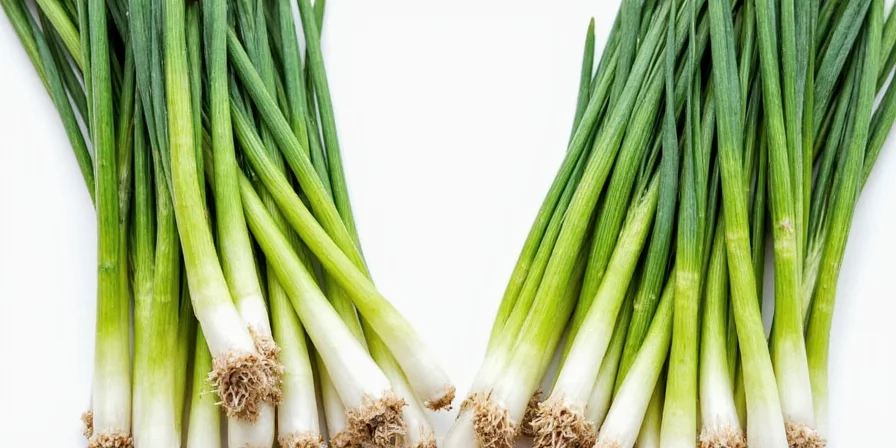Chives and green onions are NOT interchangeable—using the wrong one can ruin your dish. Here's what actually matters: green onions have a distinct white bulb and stronger flavor for cooking, while chives are completely green and mild for finishing dishes. This guide cuts through the confusion with grocery-tested identification tips, substitution rules, and exactly when you can swap them without ruining your meal.
Table of Contents
- Chives vs Green Onions: The 30-Second Identification Guide
- When Substitutions Work (and When They'll Ruin Your Dish)
- Cooking Cheat Sheet: What to Use When
- Grocery Store Test: Tell Them Apart in 5 Seconds
- Storage Hacks That Actually Work
- Debunked: 4 Common Misconceptions
- FAQ: Real Kitchen Questions Answered
Chives vs Green Onions: The 30-Second Identification Guide
You've seen them side-by-side in the grocery store. Here's how to tell them apart immediately:
Green Onions (Scallions)
- Has a white bulb at the bottom (even if small)
- Thicker stalks that resist bending
- Stronger, sharper onion flavor
- Works in cooked dishes (stir-fries, soups, etc.)
Chives
- No white bulb—entire plant is thin green stalk
- Delicate stalks that bend easily without breaking
- Mild, subtle onion flavor
- Only for finishing dishes (sprinkled on top)
| Feature | Green Onions | Chives |
|---|---|---|
| Bottom Section | White bulb present | Completely green |
| Best Used In | Cooked dishes | Raw/finishing only |
| Flavor Strength | Strong (like onion) | Mild (like grass) |
| Substitute Ratio | 1:1 for onions | 3x amount for similar flavor |
When Substitutions Work (and When They'll Ruin Your Dish)
Never substitute in these cases:
- Stir-fries or sautéed dishes → Green onions work; chives turn bitter and disappear
- Ceviche or acidic dishes → Green onions hold up; chives get overwhelmed
- Guacamole → Green onions balance richness; chives add almost no flavor
Safe substitutions:
- Salad dressings → Use 3x chives for same green onion flavor
- Deviled eggs → Chives make better garnish (green onions too strong)
- Scrambled eggs → Add green onions while cooking, chives after plating
Cooking Cheat Sheet: What to Use When
| Dish Type | Use Green Onions When | Use Chives When |
|---|---|---|
| Stir-fries | ✓ Add with other veggies | ✗ Never (disappears) |
| Salads | ✓ For stronger flavor | ✓ For delicate flavor |
| Soups | ✓ Early in cooking | ✗ Only as garnish |
| Omelets | ✓ Cooked inside | ✓ Sprinkled on top |
| Guacamole | ✓ Essential for balance | ✗ Adds little flavor |
Grocery Store Test: Tell Them Apart in 5 Seconds
Stand in front of them and do these checks:
- The Bend Test: Gently bend a stalk. Chives bend completely without breaking (hollow inside). Green onions resist bending and snap crisply.
- The Bulb Check: Look at the bottom. Any white section = green onion. Completely green = chives.
- The Squeeze Test: Pinch the middle. Chives feel soft and collapse. Green onions feel firm.
Storage Hacks That Actually Work
Make Green Onions Last 2 Weeks
- Trim roots and store upright in a glass with 1" water
- Cover loosely with a plastic bag
- Change water every 2 days
Keep Chives Fresh for 10+ Days
- Wrap in slightly damp paper towel
- Place in airtight container
- Store in vegetable drawer (not door)
Freezing tip: Chop chives and freeze in olive oil cubes. Green onions freeze better when chopped and dry-frozen on a tray first.
Debunked: 4 Common Misconceptions
- "Scallions are different from green onions"
Reality: They're the same thing. "Scallion" just refers to younger harvest stage. - "Chives can replace green onions in cooking"
Reality: Chives lose flavor when heated—only use raw as garnish. - "The green parts are identical"
Reality: Green onion tops have stronger flavor than chives, even when comparing just green sections. - "They're both just baby onions"
Reality: Green onions (Allium fistulosum) never become regular onions. Chives are a completely different species.
FAQ: Real Kitchen Questions Answered

Remember this rule: If it goes in the pan before cooking, use green onions. If it goes on after cooking, use chives. This simple guideline prevents 95% of substitution mistakes home cooks make.
Master this distinction and your dishes will have the intended flavor balance every time. The difference isn't just botanical—it's culinary necessity.










 浙公网安备
33010002000092号
浙公网安备
33010002000092号 浙B2-20120091-4
浙B2-20120091-4